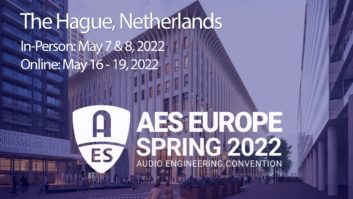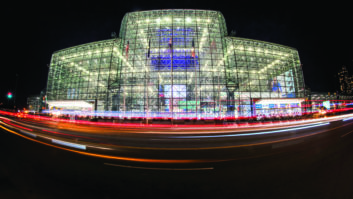I should have known it was going to be a surprisingly radio-centric AES show when the movie on my flight to San Francisco was “A Prairie Home Companion.”
Although the Robert Altman film is a sort of charming cross between “Radio Days” and “A Mighty Wind,” and features a typically great Altman ensemble cast, I still managed to fall asleep about halfway through it. But the 121st AES Convention at the Moscone Center in San Francisco was anything but sleepy, especially where radio was concerned.
Although radio topics have been on the rise at recent AES shows, the emphasis on broadcasting at this convention was astounding. There was an entire conference track of a dozen sessions on broadcast technology topics, well put together by veteran radio engineer David Bialik (I was a participant in two of the panels), plus an unprecedented number of other sessions, several of which were also of considerable interest to broadcasters.
Rites of passage
Of course, not everything at AES 121 was radio-related, but the convention is always fascinating anyway for its dichotomy, which presents a good look at an industry that is heading in seemingly opposite directions simultaneously. Reminiscent of the two-faced ancient Roman deity Janus — the god of gates and doors, or beginnings and endings — one half of the pro audio industry is pushing toward acceptable quality at ever lower bit rates, while the other half is struggling for perfection in reproduction with continually increasing resolutions.
This isn’t an illogical divergence, of course. On one hand, the perennially increasing speed of digital processors and decreasing cost of digital storage invite the extension of quality with continually higher sampling rates and quantization levels. Meanwhile, radio spectrum is a fixed and scarce resource, and even Internet bandwidth is generally gobbled up faster than it can be provided, so conservation along this axis is also welcome, particularly when it can be achieved with an increasing retention of fidelity.
Another way to look at this is that the AES is an annual convocation of guardians for both the quality and the quantity of audio delivered to the world’s audiences. While some crusade for greater efficiency in distribution, others pursue their quest for ultimate fidelity of reproduction. These are not in opposition, but in fact are two axes of a multidimensional world, and their nexus is worthy of close observation.
The richness of this environment can be gleaned from a quick perusal of the conference sessions at any AES Convention. From acoustics to transducers to amplifiers to transmission, from recording to sound reinforcement to radio to consumer electronics, from archival preservation to forensic analysis to hearing loss to aural perception, from data compression to sound-for-picture to audio effects to surround sound, AES covers the four corners of the audio universe — which in its own right is also expanding.
The growing popularity of the sonic theme park that is AES is evidenced by its numbers, which show strong growth year to year, even in periods when other shows struggle. Twice each year the pro audio world gathers — each fall in the United States (on alternating coasts) and in the spring in Europe , with subject- and region-specific smaller conferences around the world in between. Advantageously, the concentration of audio professionals in cities like New York and Los Angeles make the frequent placement of AES conventions in those cities certain to draw at least a strong minimum attendance from locals; yet each show generally attracts strong national and worldwide attendance.
AES also puts equal emphasis on theoretical and practical elements of the audio business. Extremely deep technical paper presentations square off against hands-on or practical workshops and tours of local facilities, often requiring agonized decisions over how to divide your time at the show.
This structure coupled with a refreshingly ethical balance of academic and commercial attitudes provides each AES convention with something for everyone to like. It also makes the show stand apart from others — it’s not NAMM, NAB or SMPTE, but something all its own. It’s also reflective of the multifaceted industry that it serves, which has always juxtaposed long hair and leather with patch cords and pocket protectors. Thus the fashionistas of AES make an interesting and unique statement as they parade through the halls.
The age diversity of an AES show is also remarkable. The elders of the industry mingle freely with students, and they both seem to learn something from each other at every show.
Surrounded by 5.1
This year it seemed you could hardly take a step in any direction without encountering surround sound, in either a recording or a broadcasting context. There is no question that surround is the next wave in audio, and it’s not just for soundtracks anymore.
No less than 10 different conference sessions focused exclusively on surround sound issues, and the subject was mentioned countless times in other instances throughout the show, as well. Attendance at most of these sessions was strong, indicating continuing growth of interest in multichannel sound. For the first time it seemed like stereo could eventually become the mono of tomorrow, acquiring the status of a legacy audio format (at least for musical content).
Radio itself had a higher overall profile at this year’s AES than ever, with sessions running the gamut from IBOC to IP Audio. The new Association of Public Radio Engineers also took the opportunity to meet at the show for the first time, an event that reportedly may become an annual affair.
For radio engineers who have never attended an AES show, it’s an opportunity worth seeking out. For those who have, it’s only getting better for broadcasters every year.










